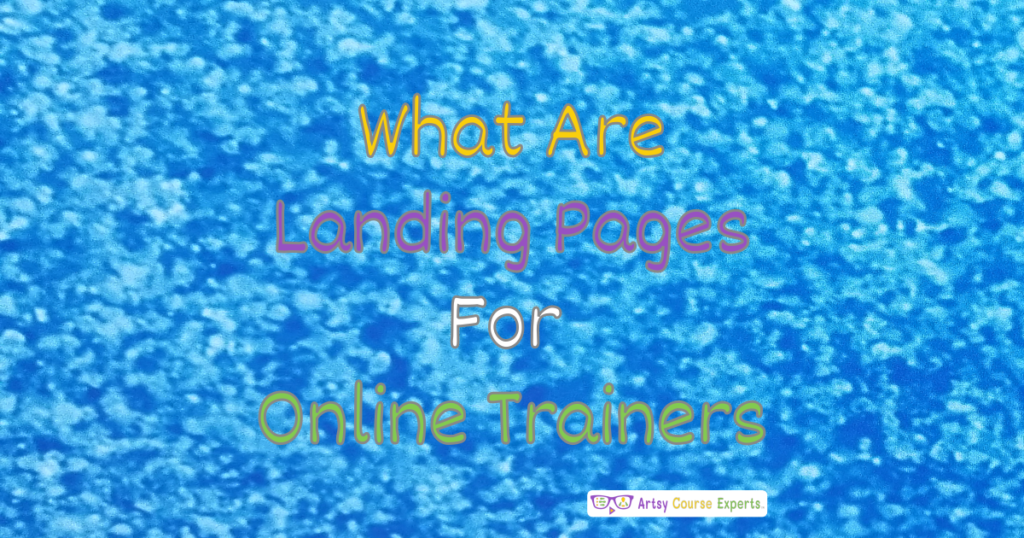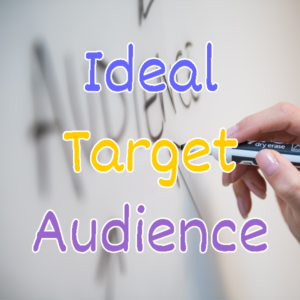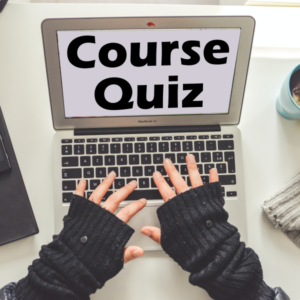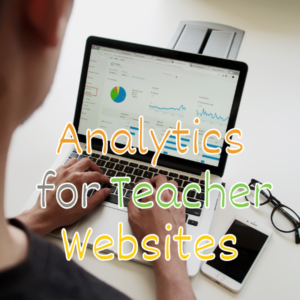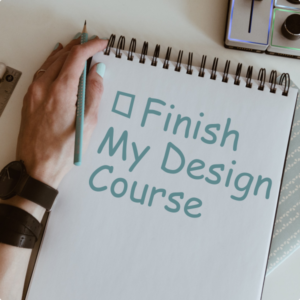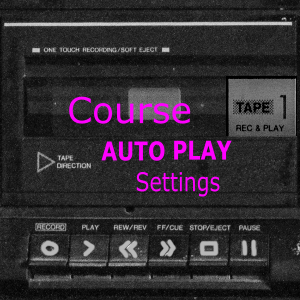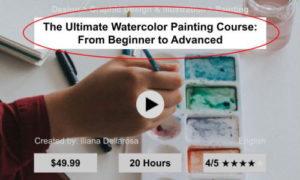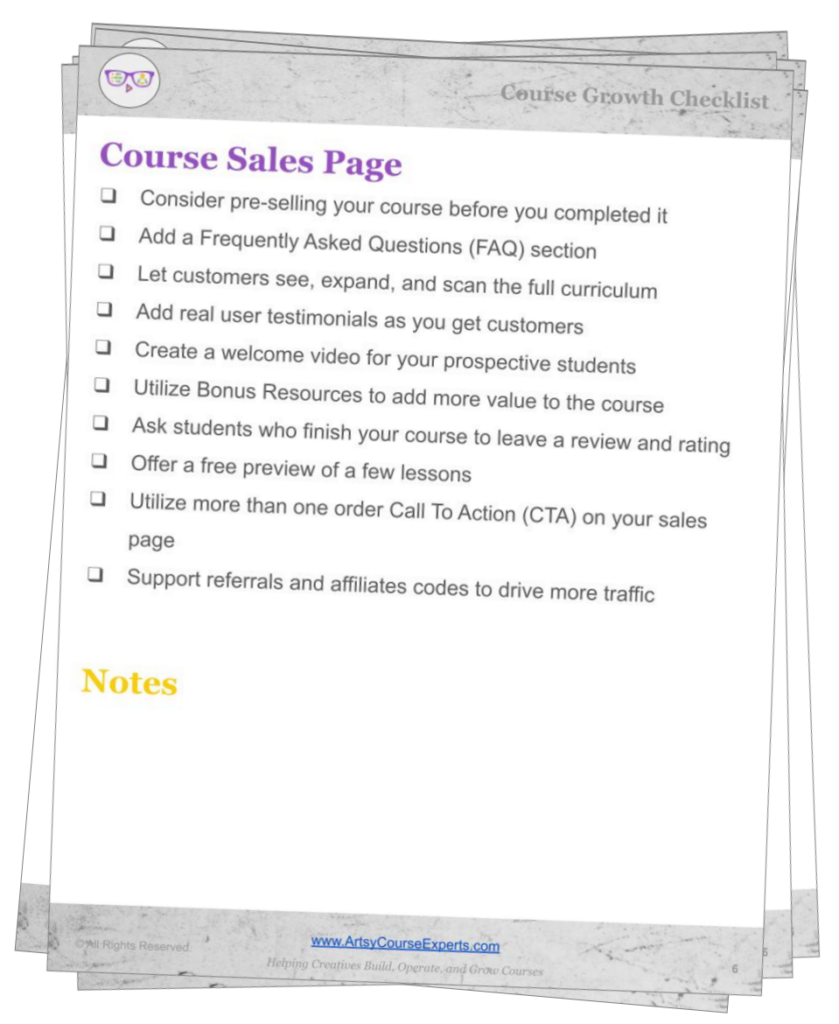Introduction
If you plan to run an advert with your course, then you need to learn about landing pages and how they can help you sell your course and turn prospects into students. Landing pages help you get a specific response or reaction from people going through your ad.
In this lesson, we’re going to learn all about landing pages. We’re going to know what they are? Why use them? What’s on a landing page and how to use landing pages to sell your products and services. Then we’ll go over an example. Finally, we’ll summerize our top tips.
Challenges online course creators may face when they do not use landing pages:
- It may be difficult to convert prospects into students
- They may not sell their courses or invite prospects to their webinar
- They may not utilize the bonus offers to reach a wide range of prospects
- They may not have the chance to get a specific reaction from their target audience
- They may not be able to learn about their prospects and their choices
Who Can Use?
Almost any kind of teacher, professional, or coach can use landing pages to learn more about their prospects, get them to perform specific actions and increase sales in their business.
Here are some examples of how teachers helping creative students can use Landing pages:
- Connect with prospects and students to improve online sales
- Learn more about your prospects and know the right buttons to ask them to click
- Grow your website coaching business by having your ads have a catchy call to action and next step process.
This can work for a range of educational businesses like teaching sketching, metal making, costume design, script writing, juggling, and songwriting.
What Is It?
It’s a web page used to provide information and next-step options after an ad or a promotion. So if one of your prospects sees an ad or a promotion, they click on this ad or promotion or this link or whatever, and then they go to your landing page.
It’s a very focused website just to give information. So that they can take the next step to learn more, here’s an email, buy it, whatever that next step is. So it’s a very dedicated webpage.
Why Use It?
The landing page is used to grab attention and entice a prospect to take action, like share their email or buy something. It’s a very dedicated web page. It usually doesn’t even have a menu. It may not even have a footer. Other than my Privacy in terms of service.
It’s really focused. It has a headline. It gives them real specific information. It connects to that prospect with a problem that they’re having, and it has very dedicated buttons so that they can either give you their email or buy something.
It almost has no exit ramps, so think of a highway where the only direction is forward to the goal that you want on that sales page. That’s what a landing page is and it’s different from your dot com web page.
It has a menu and navigation and a sidebar and lots of other content and lots of little paths right with web pages. People can choose their own adventure, but with a landing page, you’re taking them very specifically down a path so that you’re going to teach them about something. You’re going to identify their problem, tell them about your solution, and then encourage them to take that one and only next step.
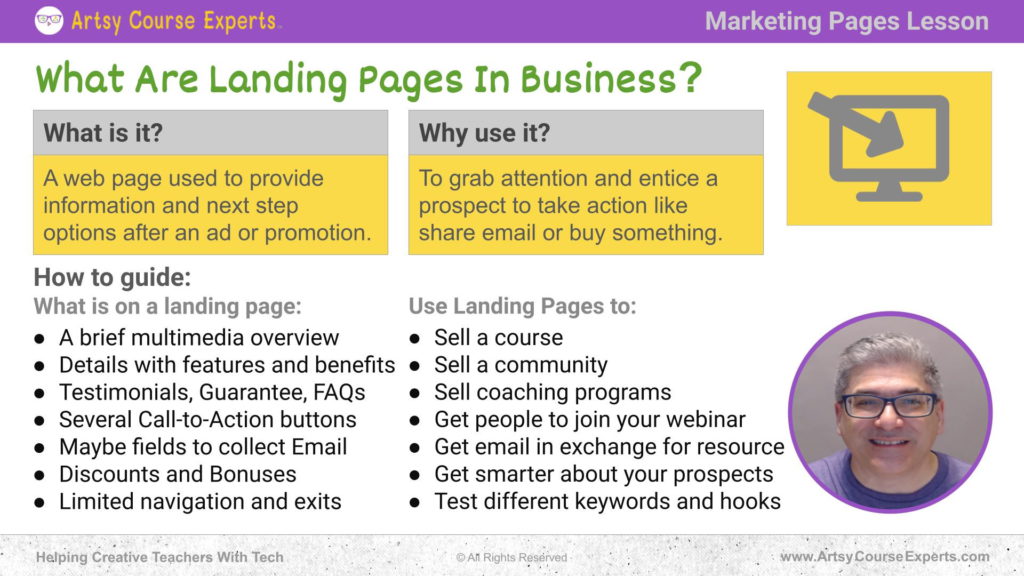
How-to Guide
So let’s go into how to guide you in understanding how a landing page works.
What Is on a Landing Page:
A Brief Multimedia Overview
The first thing you’ll have on this landing page is some sort of multimedia overview. A headline, video, hero image. Something that really identifies why they’re here and the main purpose of your product or service. So some sort of big heading with an image or a video intro from you or it could be a polished video but it’s basically a main above the fold, right?
So they don’t have to scroll as soon as they get there. They’re seeing this overview about your product or service. So that’s the number one thing that you’re going to have on that landing page.
Details with Features and Benefits
Little by little, you’re going to start going over all the different features and benefits and what your product and service does.
You might also have details about who this landing page or service is for and who it’s not for. So you can have all those kinds of things depending on your story writing or approach. You can keep it very factual, or you can bring them through a journey that says, “hey, we do this, if you’re in this situation, let us help you”.
Testimonials, Guarantee, FAQs
On your landing page, you’re probably going to have testimonials. A guarantee and frequently asked questions. So the testimonial is going to provide social proof that you’ve helped other people and it’s real and it works and they’ve gone through transformations. They’ve reached that end state that you’re promising on your landing page.
The guarantee is going to reduce risk and say, “hey, look, if it doesn’t work out, I’ll give you some money back or no worries”. That depends on what kind of guarantee you want to offer. It could simply just be a satisfaction guarantee without money back, however you want to frame it.
Then you’re going to have a frequently asked questions section and you’re just going to have like just a handful of questions, maybe five important questions.
At first you’re going to invent these questions, like how much does it cost? Is there a refund? How fast does it work? All this sort of stuff. Well, I have access to the content forever, So there’s these kinds of popular questions in e-learning.
Then over time you’re going to get your own specific questions and they’ll be very specific to what you’re teaching, whether it’s, design or fashion or making audio visual, whatever it is that you’re teaching, you know, that your creative thing, there might be something very specific that you might want to answer as you’re selling.
As you’re learning to remove those obstacles and just answer them so that they’re ready to just scroll down the page and buy,
Several Call-To-Action Buttons
You’re going to have several call to action buttons. So you’ll have one at the very beginning when they get there. “hey, you know this is our service”, and they can have a buy now button. You might have one somewhere in the middle after you explain all the features and details of what you do. And then you’ll have one at the very end because certain apps like Facebook and tiktok or whatever are training everybody to just scroll through the feeds.
So if people are just scrolling through and skimming your headlines at the very end you want them to buy that’s their last chance, So you’ll definitely want to have a button there and these call to action buttons could have really interesting texts. They could even have little arrows and icons or big fonts or whatever, so they don’t all have to say buy now.
They could say they could learn how to play music now or how to design or how to make your own t-shirts now, or whatever it is that you do so you can work in that transformation, or even stopping something like stop messing up in illustrator or stop wasting time in the final cut.
Whatever it is that you do, you can work those into those buttons. So you can even have a mix, and you can buy now, learn now. Start doing something now, so you can have a variety of those buttons. But anyway, you’re gonna have a couple of call to actions, spread on your landing page.
Maybe Fields to Collect Email
You might even have fields like their name and email that don’t have too many fields. You want to guarantee that they get to that landing page you possibly paid good money for ads, so don’t really want this to convert? So don’t ask for a bunch of fields if you’re going to ask for an email. get their name and email or even just their email Right and a subscribe button.
Maybe it’s a lead magnet so if you’re going to get an email, Make that your main thing. And then you could sell them on the backend or make buying the main thing and maybe don’t confuse them with two different options. So they don’t get analysis paralysis.
So you’re going to decide your strategy to either sell or get their email and then you can keep selling. Now you have a warm lead that over weeks and months, you can keep giving them more information. Otherwise, if they don’t buy and they go away, maybe you can use a retargeting pixel, but you’ll lose that lead.
Discounts and Bonuses
Often on landing pages, people might include discounts or bonuses or even some sort of urgency, like, “Hey, limited time only”, maybe it’s a countdown clock where it’s still the same price, but in the next 24 hours. You’re also going to get this bonus thing or template. This extra thing is worth another value.
You’ll call out worth a hundred dollars, you’ll get access to 60 days in your community, some other thing that you’re going to add to really entice them. That’s usually put at the lower parts of the page when they haven’t clicked the first two calls to actions. You’ll include those bonuses or a discount to just motivate them further to try to get them to click that buy button.
Finally, from a landing page point of view, this is not a regular website. Yeah. Behind the scenes, there’s still a server and all that stuff. You’re coming in through a browser or a mobile app, but the landing page, from a design point of view, doesn’t have a lot of exits, a lot of navigation.
It really wants you to get this information and then at each step forward, try to get you to buy or give that, give your email. So that’s what you want to do and you don’t want to have a lot of options on the footer, a whole menu.
There’s a bunch of different designs, whether you keep your landing pages short or there’s this long landing page with lots and lots of information. But the point is they’re not leaving your site or changing the page. They’re there and you really have one purpose, which is to get them to buy or to give you their email.
so you can use landing pages for a couple of things. You can use it to sell your courses, you can even think of a specific course, you can sell a bundle of courses. You can just focus on one specific course that you’re trying to sell. Don’t forget, once they buy that course, at the end of that course, you can go ahead and sell and have other offers. You can use a landing page to sell your membership community.
We’re not even getting into the offer, Whether it’s month to month or annual or lifetime, that’s up to you and you can play with that, but the landing page will potentially help you sell that online community.
Use Landing Pages To:
Sell a Course
You can also use your landing page to sell your coaching programs, whether it’s a one-time coaching, a month to month, a mastermind monthly for three months or six months or six sessions. However you structure your coaching programs, but the point is you can use a landing page to sell those.
You can also use landing pages to get people to join your webinar, so you have a landing page about your webinar. You’re going to teach this certain skill set. And then maybe at the end of the webinar, you do other things, but one step at a time.
Get People to Join Your Webinar
You’re going to use this landing page to collect an email about your webinar. You’re going to send them an invitation and then at the webinar, you potentially sell something at the end . So you do it in steps.
You should make a decision on your landing page. A lot of people use landing pages to not even sell, just get the email. So once they get the email, they can offer promotions. They can show value, lot of benefits there to provide resources, tips, templates, templates, videos, and get them to subscribe to their socials.
Get Smarter about Your Prospects
So you’re hitting up your prospects on a variety of different channels. You’re going to figure out your strategy. “Hey, is it better to just get that email or no”, let me go straight to the offer. It also depends on the price of your product or service, whether it’s a low ticket item or a high ticket item.
Now landing pages are going to also help you get smarter about your prospects. You’re going to test out certain hook words, key words. You’re going to know the buttons, what’s the right button text, whether it’s buy now or save now or design better now, whatever it is that you do.
So you’re going to try these different words and you’re going to see what’s working, what’s resonating with your audience, your niche and, with the types of products and services that you sell, your creative products and services.
So that’s going to be very interesting. So you might have a variety of different buttons, a variety of different words, and then you can, get some stats, make some notes about what’s working, what’s not working, and then keep trying to level up to do a little bit better, get a higher conversion rate.
Let’s just say, 3,000 people are going to your landing page. How many of those landing pages people took the next step? You could do little experiments. or, as a teacher, you might have your things that you’re learning. So, you’re seeing landing pages from other providers.
You might say, oh, that’s a great way to display testimonials. I’m gonna use video testimonials. I’m going to include the photos of happy customers doing this thing that I teach, So you’re going to continuously level up those landing pages and try to keep improving the conversion rate of prospects to actual signups.
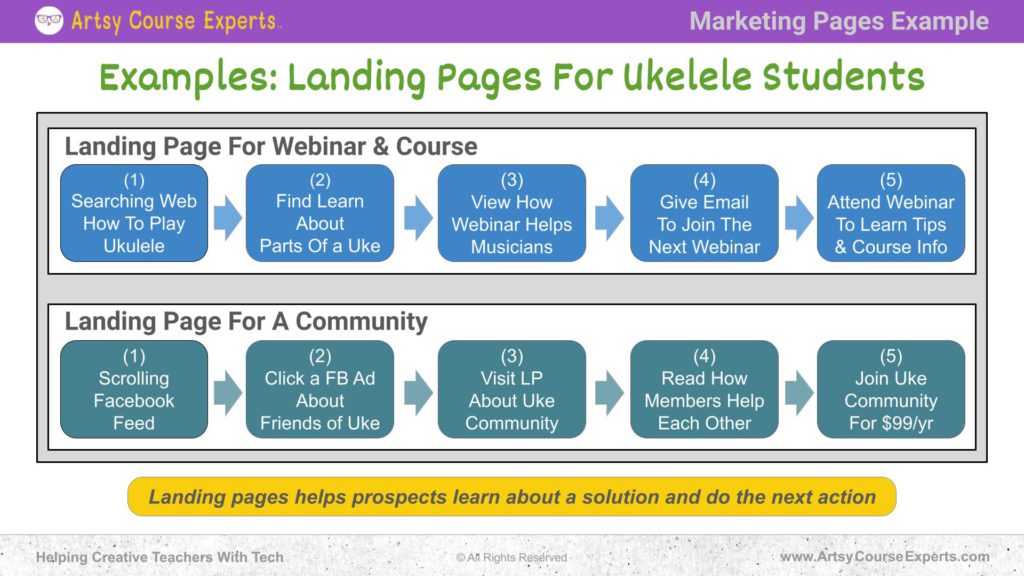
Examples: Landing Pages For Ukelele Music Students
Landing Page For Webinar & Course
Searching Web How To Play Ukulele
Now let’s check out an example. Let’s say that a client teaches music like ukulele, The little tiny guitar, they’re trying to teach ukulele and maybe they’re struggling, they just have this webpage, but they’re thinking of doing maybe ads or webinars or something else to do a little bit more, to get more conversions, more customers.
Learn About Parts Of a Uke
A bigger community, more audience. So they’re exploring landing pages. First of all, they might set up a landing page creating the ad and it’s a landing page and it’s just explaining all the different parts of a ukulele. That’s their only thing.
View How Webinar Helps Musicians
It’s almost like a freebie, but instead of just writing a blog article, they recorded a webinar. Maybe they might not have even been an audience. It might’ve just been them recording a video that’s now delivered as a webinar. Anyways, when they set this up, it would basically go like this.
Their prospects are searching the web on maybe how to play the ukulele, they happen to come across this ad that says, Hey, learn everything about the ukulele or learn all the parts of a Yuki, So that’s the ad that they create that resonates with the people who are also learning, looking to learn how to play the ukulele.
Then the online ukulele teacher goes ahead and creates that video, uses that webinar and it’s working. People are going to your landing page, giving you their email and then they’re choosing a date and time. And it’s pre-recorded.
So you could go back, go ahead and actually, do a webinar every month. But let’s just say it’s pre-recorded. It’s this one webinar where you pre-record a video, you upload it to your webinar system, and whenever they choose, maybe they get to pick a date and time, then they get to see that webinar.
Give Email To Join The Next Webinar
So because they gave you their email, the webinar system adds them to the registration and they get the link and they get to watch the webinar. At the end of the webinar, after you’re teaching your prospects all the great information about every part of a ukulele. that’s when you say, “if you like this and you want to learn more, maybe take my masterclass or you want to take my introduction to ukulele. Then click here and then you can potentially even give them a discount or promotion”. Basically, you’re doing it step by step. So they’re searching for ukulele stuff. So you get their email on your landing page which makes them happy.
Now you’re also feeding them information, maybe on your blog or adding them to your subscriber like convert kit, MailChimp, AWeber, or whatever you’re using. Now they’re getting stuck. Week after week as you’re providing other resources and tips. Eventually, they make it to your webinar and then at the end you can actually get them to buy.
You just do it in stages and that’s how you use the landing page. If the landing page were your website, they could click away. There’s just too many options on your website, but with a landing page, you’re taking them down this specific path to collect their email, teach them the thing, and then later you could potentially sell them a thing.
Scrolling Through Facebook
Now let’s just say that you also have a community for ukulele students, people playing the ukulele. So you have a community where they’re helping each other. They’re talking, they’re learning about which ones to buy, where do you get sheet music? How do you stand? Do you get a case?
How do you replace the wall, you know, the strings, all that fun stuff. So let’s just say instead of searching on you might have a prospect that’s scrolling through their Facebook feed. They’ve already told Facebook that they’re interested in music and ukuleles and guitars and all that sort of stuff.
Facebook knows their interests. Facebook knows their groups and their keywords. So at some point they’re going to see that Facebook ad that you created. it’s maybe something like friends of the Yuki, And they know that keyword, they know ukulele.
Click an FB Ad About Friends of Uke
They are clicking on that Facebook ad to go learn about what’s this friends of Uke thing.They click on it and then they’re seeing the landing page that you created. It’s all about your ukulele community. So they’re looking, they see the different groups and chat rooms that you have, they see how they can ask questions and share links and how it’s clean and moderated without a lot of other ads or junk or spam.
Visit LP About Uke Community
It’s like a moderated professional community. for ukulele players, students, et cetera, or even ukulele professionals, who know however you want to frame it, so they like that stuff and at the end of that landing page or at points in that landing page, They can go ahead and buy it.
Throughout that landing page, they’re going to see a lot of call to actions where they can join now or meet and hang with their Uke friends to level up their Uke skills or however you want to do it. Then you could have tiers or you could just simply have this one price or it could be monthly or annual.
You could have two buttons or you can have a radio button that lets them choose monthly and annual. Maybe you default to annual, you can decide as that creative business owner what would be the discount if they did give you cash up front to subscribe all year.
Maybe you give them one or two months off. You can include something like a PDF as a bonus so you can decide those things and you can also frame it up. As you’re playing with the text to try to increase your conversion rate, but that’s how you would use a landing page to do a hard sell.
So right from the beginning if they get there you’re going to offer this one or two different options. So that they can buy that product or service.
In the end, creative businesses like yours that teach online are going to use landing pages to help their prospects grow, learn about some sort of solution and do one next step, whether it’s give you their email or get them to buy something.
It can be a small product. It doesn’t have to be your biggest product. It could be a big product or it could be a small to medium product that over time you sell them as they learn more about your business.
FAQ on Landing Pages for Online Creative Teachers

Summary – What Are Landing Pages for Online Creative Teachers
The main goal is to teach your prospect and connect with your prospect about some product that you have, a product or a service, and to get them to do that one next step.
It could be to give you their email, or to buy something. If you offer to buy, don’t have many options. Maybe there’s an upsell after they click that button to upgrade or to buy. To also opt into a bundle to save more, but you don’t want to confuse them.
They’re interested. You’re going to give them more information and you want them to take that one next step. You can use landing pages to sell your courses, your communities, or even your coaching programs.
Tips for creative online course creators when using Landing pages
- A landing page is a dedicated web page
- It doesn’t have a lot of navigation or exits or other links
- The aim is to connect your prospect with your product or service
- It could be to give you their email or buy something
- You can use a landing page to get people to join your webinar
You should be a little more smarter now. Thanks for hanging out!
Please subscribe to get more tips for creative online course teachers.
More Tips For Online Teachers
These lessons can also help you with Education and Course Content:

